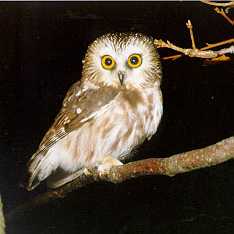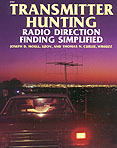Note: The Saw-whet monitoring project concluded in fall/winter 2002/2003. The original writeup below gives an excellent background and history of this project.
You Can Help Study the Saw-whet Owl
by Scott Weidensaul
 Charming and mysterious, the Northern Saw-whet Owl (Aegolius acadicus) is the smallest owl in eastern North America, and one of the least understood. Now, researchers are using radio-telemetry to study them, and they're asking hams and VHF monitoring enthusiasts for help.
Charming and mysterious, the Northern Saw-whet Owl (Aegolius acadicus) is the smallest owl in eastern North America, and one of the least understood. Now, researchers are using radio-telemetry to study them, and they're asking hams and VHF monitoring enthusiasts for help.
This fall (2002), saw-whets --- which weigh barely as much as a robin and stand just 8 inches tall --- are being fitted with 1.9-gram radio transmitters in an effort to better understand their migratory behavior and ecology. The owls are to be tagged in Schuylkill County, Pennsylvania, about 15 miles north of Reading, and in November and December can be expected to either continue south through the central and southern Appalachians, or to move south and east into the Piedmont and coastal plain. It is believed that most saw-whets migrating through Pennsylvania spend winter in the mid-Atlantic states from Maryland to the Carolinas. But little is known about their winter range, and the tagged owls may show up anywhere between the Mason-Dixon Line and Alabama or Georgia, and west through the Appalachian and Cumberland plateaus.
The radio telemetry is being conducted by a volunteer research team sponsored by the Ned Smith Center for Nature and Art, a nonprofit organization in central Pennsylvania, with support from the Pennsylvania Wild Resource Conservation Fund. Each autumn, the team nets, bands and releases hundreds of these tiny raptors at three banding stations, luring them into nearly invisible mist nets by playing a tape recording of the owl's call. The center also plays a key role in coordinating an informal network of 13 owl-banding stations across Pennsylvania, which in turn is part of a multi-state banding effort stretching from Maine and Ontario to the southern Appalachians.
The Ned Smith team is not trying to follow the owls in active migration --- the mountainous terrain in the central Appalachians, and the small size of the transmitters, makes that extremely difficult. Their research instead focuses on how the owls behave and live during the periods when they take a break from active migration --- what scientists call "stopover," which may last days or even weeks. Thus, owls that are caught twice within a couple of days are the ones being fitted with radios, in the hope that they will stick around at least a few days more, giving researchers a chance to study their habitat use, roost selection and diet. But once they move south again, it is possible that hams and VHF monitoring enthusiasts will pick up their signals, providing valuable information about where they eventually wind up.
The saw-whet owl, named for a rarely heard call likened to a file "whetting" the teeth of a saw, is a small forest-dwelling bird that preys primarily on mice and small rodents. It breeds in thick forest across southern Canada and the northern USA, and down the Rockies and Appalachian mountains. Secretive and rarely seen, it is more often heard; the male's territorial call is a repetitive "tooting" very much like the back-up alarm on large truck.
Far from being endangered, saw-whets are probably rather common within their range, but their shy nature makes them very difficult to study. Until a century ago, no one even knew they were highly migratory, and until researchers in Wisconsin invented a technique using a tape recording of the male's call to lure them into mist nets, they were very difficult to catch for banding. Much remains to be learned about their ecology and behavior, and telemetry is one of the most promising techniques.
The transmitters are mounted on the owls using a figure-eight harness made of elastic beadwork cord, designed to allow the transmitter to fall off after several months. Each of the tiny radios is fitted with a battery expected to last at least three months.
The frequencies are:
172.0179 MHz -- Affixed in mid-November 2002. No longer active.
172.0614 MHz -- Affixed in mid-November 2002. No longer active.
172.0403 MHz -- Affixed in mid-November 2002. No longer active.
172.1392 MHz -- Affixed in mid-November 2002. No longer active.
172.1572 MHz -- Affixed in mid-October 2002. No longer active.
172.3927 MHz -- Affixed in mid-October 2002. No longer active.
172.0792 MHz -- Affixed in mid-October 2002. No longer active.
172.110 MHz -- Affixed 11/20/2001. No longer active.
172.173 MHz -- Affixed 10/26/2000. No longer active.
 Go to Frequently Asked Questions about Wildlife Monitoring, including equipment suggestions
Go to Frequently Asked Questions about Wildlife Monitoring, including equipment suggestions
 Back to the Volunteer Wildlife Tracking page
Back to the Volunteer Wildlife Tracking page
Back to the Homing In home page
This page updated 20 May 2006
 Charming and mysterious, the Northern Saw-whet Owl (Aegolius acadicus) is the smallest owl in eastern North America, and one of the least understood. Now, researchers are using radio-telemetry to study them, and they're asking hams and VHF monitoring enthusiasts for help.
Charming and mysterious, the Northern Saw-whet Owl (Aegolius acadicus) is the smallest owl in eastern North America, and one of the least understood. Now, researchers are using radio-telemetry to study them, and they're asking hams and VHF monitoring enthusiasts for help.

